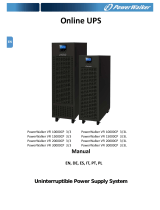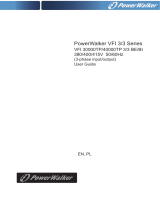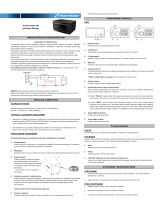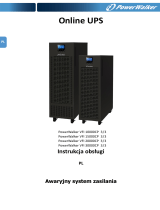Adler Power CO-SinusUPS-400W Instrukcja obsługi
- Kategoria
- Zasilacze bezprzerwowe (UPS)
- Typ
- Instrukcja obsługi

14
SINE WAVE INVERTER
MODEL: CO-SinusUPS-400W
USER MANUAL
Please read and save this manual!
This manual is an important instruction that you should follow during
installation and maintenance of the inverter. Please read all instructions
before using the equipment and save this document for future reference.
CO-sinusUPS-400W-manual-R3, 20.03.10
7. SPECIFICATION
Model
CO-SinusUPS-400W
Output Power
500VA/400W
Input Voltage / Frequency
155 ÷ 290VAC ± 7VAC; 50Hz
Output Voltage Range (AC mode)
200 ÷ 250VAC ± 7VAC
Output Voltage and Frequency (Battery mode)
220VAC ± 10VAC / 50Hz
Transfer Time
max. 10ms
Battery Voltage
12VDC
Charging Current
max. 6A
Output Waveform (Battery mode)
Sine Wave
Operation Temperature
0 ÷ 40°C
Operation Humidity
30 ÷ 95%
Overload alarm
460W ± 50W
Dimensions
206 x 246 x 104mm
Net Weight
6kg
8. FRONT PANEL
9. BACK VIEW
1
2
1. Main control button.
2. LEDs of operation status.
1. Power cord.
2. Breaker
3. Battery Connector (12VDC)
4. Output Socket
5. Cooling Fan
APPLICATIONS: Heating and warm utility water systems,
solar systems, household appliances such as Home Theater,
TV, VCD, DVD, Lamp, Fan, etc.

32
1. INTRODUCTION
2. MAIN FEATURES
This product is an advanced line-interactive pure sine wave inverter that provides backup power for your equipment.
Unlike the traditional off-line inverter, this series is also characterized by low harmonic distortion and has a very
short transfer time when the input AC fail occurs. It provides efficiency over 98% under normal power conditions.
Two charge modes, quick charge and trickle charge are provided to maintain the condition of batteries.
• Pure sine wave output.
• Microprocessor-based design.
• True Line-interactive structure.
• Smart charging.
• Real time auto-detection of battery condition.
3. OPERATION
SAVE THIS INSTRUCTION. The manual is an important document that you should follow during installation and maintenance of the
inverter and batteries. Please read all instructions before using the equipment and save this manual for future reference.
1. Connect the RED battery cable to the positive terminal (B+) and the BLACK one to the negative terminal (B-) of the battery. The
cables and terminals are to be connected firmly. Short circuit between the B+ and B- terminals, as well as the reverse polarity
connection are strictly forbidden.
2. Connect your equipment to the inverter. To ensure that your device will be protected during a utility failure, it is important to make
sure that the maximum power required by the equipment does not exceed capacity of the inverter. Alarm will set off once the load is
over the rated value. In case of significant overload, the inverter will shut down immediately in order to protect internal circuitry.
3. DC start: During an input AC failure, push the button for 3 seconds. The inverter will be turned on and enter the backup mode. To
turn off the inverter, please push the button for 3 seconds.
4. Once the device is connected to the AC mains ,there is no output voltage and the inverter will charge the battery
automatically(LED NORMAL is flashing). Please push the button on the front panel for about 3 seconds to turn on the inverter (LED
NORMAL is getting lights).
5. In battery mode, when battery voltage is too low, the inverter will emit alarm. If the voltage is too much low/high the inverter will
turn off itself automatically.
6. When a input AC fail occurs, the buzzer will emit beeps every 8 seconds for alarm. User can disable the alarm by setting silence
mode, which is to push the control button when it is beeping, and to again will enable the alarm.
7. Autorestart: In DC mode, UPS discharges battery till run out and cut off to protect against deep discharge. UPS autorun when AC
recover.
8. AC mode: To turn off the UPS please push button for 3 seconds. If UPS is connected to mains it will keep charging battery. Please
pull out the power cord and disconnect battery if you want to turn off the UPS completely.
4. LED DISPLAY AND ALARM
5. TROUBLESHOOTING
Problem
Possible Causes
Action to take
Inverter is not starting when connected
to the mains voltage supply
1. Line cord plug is loose.
2. Breaker is broken.
3. Wall socket is damaged.
1. Check the line cord plug.
2. Replace the breaker.
3. Check wall socket with a lamp.
Output voltage is present,
inverter emits continuous beep sound,
the yellow LED flashes every 0.5 seconds
Inverter is overloaded
Turn off inverter and unplug excessive loads.
No output voltage, inverter emits
continous beep sound
Inverter has shut down due to
severe overload.
Unplug excessive load and turn on the inverter again.
Inverter does not provide expected
backup time
1.Excessive loads connected.
2.Battery is weak and cannot
provide enough energy.
Do not draw any current from the inverter. Leave the
the device plugged in to the mains voltage for 10
hours. Then test it again. If inverter still can not provide
expected backup time, battery should be replaced.
Button on front panel does not work
1.The CPU inside inverter
is not running correctly.
2.Button is damaged.
Unplug line cord and battery terminals from the
inverter to let it shut down automatically. Then, plug in
line cord and battery again. If the button still fails,
please call the service.
Inverter cannot turn on the battery mode
1. Battery polarity is wrong.
2. Battery is overcharged.
3. Battery is discharged.
4. Inverter fault.
1. Check battery and connections.
2. Check battery voltage using a voltmeter.
3. Connect the inverter to mains voltage and charge
the battery.
4. Call the service.
6. IMPORTANT SAFETY INSTRUCTIONS
•
• Keep batteries away from fire in order to aviod explosion.
• Do not open batteries. Released electrolyte is harmful to skin and eyes.
• A battery can present a risk of electric shock and high short circuit current. The following precautions should
be taken when working on batteries.
• Remove watches, rings and other metal objects.
• Use tools with insulated handles
•The equipment cannot be operated by any unexperienced person.
•The socket shall be installed near the equipment and be easily accessible.
• Attention: Electric shock hazard! Even after disconnecting the unit from the mains voltage supply, hazardous
voltage level may be present, since the battery is still connected to the device.
• The battery supply should be therefore disconnected when maintenance or service work inside the inverter is to be done.
• The lead acid battery may cause chemical hazard.
• The battery presents a risk of electric shock and severe short circuit due to high energy density
Warning!
Due to the forced air circulation used in UPS, keeping the device clean (including the inside of the device) is the user
responsibility. Failure to comply with the above recommendation may result in the loss of warranty rights.
When replacing the batteries, use the same number and the same type of batteries.
• Overload, short circuit, & over temperature protection.
• Isolation between battery and AC circuitry.
• Good dynamic performance.
• Speed control of cooling fan.
Mode
Status
Blue LED
NORMAL
Red Dioda LED
BACKUP
Yellow Dioda LED
OVERLOAD
Alarm /
Buzzer
Battery
mode
Normal (silence mode
disabled)
No signal
Lights
No signal
No alarm
Normal (silence mode
enabled)
No signal
Lights
No signal
Beep
every 8s
Low battery voltage
U > 10.1V)
BAT
(8.9 >
No signal
Lights
No signal
Beep
every 1s
Output Overload
No signal
Lights
Flashes
Continous
Output Short circuit
No signal
Lights
No signal
Continous
Mode
Status
Blue LED
NORMAL
Red Dioda LED
BACKUP
Yellow Dioda LED
OVERLOAD
Alarm /
Buzzer
AC mode
Charging battery, output
off
Flashes
No signal
No signal
No alarm
Normal (U > 9V)
BAT
Lights
No signal
No signal
No alarm
Too high battery voltage
(U > 15V)
BAT
No signal
No signal
No signal
Beep
every 0.5s

14
INWERTER Z FUNKCJĄ UPS
MODEL: CO-SinusUPS-400W
INSTRUKCJA OBSŁUGI
Przeczytaj i zachowaj instrukcję !
Niniejszy dokument jest instrukcją, której należy przestrzegać w trakcie
instalacji i użytkowania urządzenia. Zapoznaj się z zawartymi w niej informacjami
przed uruchomieniem urządzenia i zachowaj niniejszą instrukcję do wykorzystania w przyszłości.
CO-sinusUPS-400W-manual-R3, 20.03.10
7. SPECYFIKACJA
Model
CO-SinusUPS-400W
Moc wyjściowa
500VA/400W
Napięcie wejściowe / Częstotliwość
155 ÷ 290VAC ± 7VAC; 50Hz
Zakres napięcia wyjściowego (Tryb AC )
200 ÷ 250VAC ± 7VAC
Napięcie wyjściowe / Częstotliwość (Tryb bateryjny)
220VAC ± 10VAC / 50Hz
Czas przełączenia
max. 10ms
Napięcie akumulatora
12VDC
Prąd ładowania
max. 6A
Kształt napięcia na wyjściu (Tryb bateryjny)
Sinusoida
Temperatura pracy
0 ÷ 40°C
Wilgotność pracy
30 ÷ 95%
Alarm przeciążenia
460W ± 50W
Wymiary
205 x 246 x 104mm
Masa netto
6kg
8. PRZEDNI PANEL
9. WIDOK Z TYŁU
1
2
1. Główny przycisk sterowania.
2. Diody LED statusu działania.
1. Kabel zasilający
2. Przerywacz
3. Złącze akumulatora (12VDC)
4. Gniazdo wyjściowe
5. Wentylator
ZASTOSOWANIE: Systemy CO, CWU, solarne,
Sprzęt AGD np. kino domowe,
TV, VCD, DVD, lampy, wiatraki, itd.

3
2
1. WPROWADZENIE
2. GŁÓWNE CECHY
Niniejsze urządzenie to zaawansowany inwerter liniowy, z przebiegiem wyjściowym w postaci czystej sinusoidy. W
przeciwieństwie do tradycyjnego inwertera off-line, zapewnia również niskie zniekształcenia harmoniczne i charakteryzuje
się krótkim czas przełączenia w tryb bateryjny, gdy wystąpi zanik napięcia sieciowego. Zapewnia sprawność ponad 98% w
normalnych warunkach zasilania. Dwuetapowe ładowanie (szybkie i podtrzymujące) pozwala utrzymać akumulatory w jak
najlepszym stanie.
• Czysty sinus na wyjściu.
• Konstrukcja oparta na mikroprocesorze.
• Topologia line-interactive.
• Inteligentny proces ładowania.
• Automatyczne wykrywanie stanu baterii w czasie
rzeczywistym.
3. MONTAŻ I INSTALACJA INWERTERA
ZACHOWAJ INSTRUKCJĘ. Niniejsza instrukcja zawiera ważne wytyczne, których należy przestrzegać podczas instalacji, użytkowania oraz
konserwacji inwertera i akumulatorów. Przed uruchomieniem urządzenia należy zapoznać się z niniejszym dokumentem i zachować go.
1. Podłącz czerwony przewód akumulatora do zacisku dodatniego, a czarny do zacisku ujemnego. Wymagane jest mocne(pewne)
podłączenie przewodów akumulatora do zacisków . Zwarcie między zaciskami akumulatora, jak również odwrócenie biegunowości są surowo
zabronione.
2. Podłącz obciążenie do Inwertera. Aby zapewnić, ochronę urządzeń podczas awarii sieci, ważne jest, upewnienie się, że maksymalna moc
potrzebna dla danego urządzenia nie przekracza znamionowej mocy inwertera. Jeśli obciążenie przekroczy wartość znamionową zostanie
wyemitowany alarm dźwiękowy. Jeżeli wystąpi głębokie przeciążenie, urządzenie zostanie automatycznie wyłączone celem zabezpieczenia
przed uszkodzeniem.
3. Rozruch z akumulatora: aby załączyć urządzenie podczas braku napięcia sieciowego AC należy nacisnąć przycisk i przytrzymać przez 3
sekundy wówczas inwerter zostanie załączony i przejdzie w tryb bateryjny. Aby wyłączyć inwerter nacisnąć przycisk i przytrzymać przez 3
sekundy.
4. Po podłączeniu do sieci AC bateria jest ładowana a na wyjściu urządzenia nie ma napięci(dioda LED NORMAL miga). Aby załączyć urządzenie
należy nacisnąć przycisk na przednim panelu i przytrzymać przez około 3 sekundy (dioda LED NORMAL świeci ciągłym światłem).
5. W trybie bateryjnym, gdy napięcie akumulatora jest zbyt niskie lub zbyt wysokie zostanie to zasygnalizowane alarmem dźwiękowym. W
przypadku znacznego spadku lub przekroczenia napięcia akumulatora urządzenie wyłączy się automatycznie.
6. W przypadku zaniku napięcia sieciowego co 8 sekund zostaje emitowany alarm dźwiękowy. Użytkownik może wyłączyć dźwięk poprzez
naciśnięcie przycisku głównego podczas trwania alarmu, wówczas urządzenie przechodzi w tryb cichy. Aby wyłączyć tryb cichy należy
ponownie nacisnąć przycisk główny.
7. Autorestart: Podczas pracy w trybie bateryjnym akumulator jest rozładowywany do bezpiecznego poziomu aby zapobiec jego głębokiemu
rozładowaniu po czym urządzenie wyłącza się automatycznie. Po podaniu napięcia zasilania AC urządzenie automatycznie powraca do
normalnej pracy.
8. Tryb sieciowy: W celu wyłączenia urządzenia należy nacisnąć i przytrzymać przycisk przez 3 sekundy. Jeśli napięcie zasilania jest podłączone
inwerter będzie w dalszym ciągu ładować akumulator. Aby całkowicie wyłączyć urządzenie należy odłączyć zasilanie urządzenia (wyciągnąć
przewód wejściowy z gniazdka) oraz odłączyć akumulator.
4. SYGNALIZACJA I FUNKCJONALNOŚĆ
5. ROZWIĄZYWANIE PROBLEMÓW
Problem
Możliwe przyczyny
Czynności do wykonania
Po podłączeniu do sieci, urządzenie
się nie załącza.
1. Wtyk sieciowy jest luźny.
2. Uszkodzony wyłącznik.
3. Uszkodzone gniazdo sieciowe.
1. Sprawdź wtyk sieciowy.
2. Wymień wyłącznik.
3.Sprawdź gniazdo sieciowe.
Inwerter pracuje poprawnie, emitowany
jest ciągły sygnał dźwiękowy
Inwerter jest przeciążony.
Wyłączyć inwerter i zmniejszyć obciążenie do wartości
znamionowej.
Brak napięcia na wyjściu, emitowany jest
ciągły sygnał dźwiękowy
Inwerter został wyłączony z
powodu dużego przeciążenia.
Wyłączyć inwerter i zmniejszyć obciążenie do wartości
znamionowej.
Czas podtrzymania jest zbyt krótki
1.Inwerter jest przeciążony.
2.Pojemność akumulatora jest za
niska.
Inwerter pozostaw podłączony do sieci przez 10
godzin, nie obciążając wyjścia. Następnie przetestuj
ponownie. Jeśli urządzenie nadal nie zapewnia
oczekiwanego czasu pracy, należy wymienić baterię.
Przyciski na przednim panelu nie działają
1. Uszkodzenie mikrokontrolera.
2. Uszkodzone przyciski.
Odłącz, a następnie podłącz ponownie przewód
sieciowy oraz akumulator. Jeśli przyciski nadal nie
działają, skontaktuj się z serwisem.
Urządzenie nie przechodzi w tryb
bateryjny
1. Niepoprawna polaryzacja
akumulatora.
2. Akumulator przeładowany.
3. Akumulator rozładowany.
4. Uszkodzenie inwertera.
1. Sprawdź akumulator i połączenia.
2. Sprawdź napięcie akumulatora.
3. Podłącz zasilanie sieciowe aby naładować
akumulator.
4. Skontaktuj się z serwisem.
6. WAŻNE INSTRUKCJE DOTYCZĄCE BEZPIECZEŃSTWA
•
• Nie wrzucaj akumulatorów do ognia - zagrożenie wybuchem.
• Nie otwieraj ani nie uszkadzaj akumulatorów, uwolniony elektrolit jest szkodliwy dla skóry i oczu.
• Akumulator może stwarzać ryzyko porażenia oraz poparzeń. Podczas pracy przy akumulatorach należy zachować
następujące środki ostrożności:
• Ściągnij zegarki, pierścionki oraz inne metalowe przedmioty.
• Używaj narzędzi z izolowanym uchwytem.
• Sprzęt nie może być obsługiwany przez osoby bez doświadczenia.
• Gniazdo elektryczne powinno być zainstalowane w pobliżu urządzenia i łatwo dostępne.
• Uwaga: niebezpieczeństwo porażenia prądem elektrycznym! Po odłączeniu urządzenia od napięcia sieciowego (praca
bateryjna), na wyjściu urządzenia nadal utrzymuje się wysokie napięcie.
• Gdy trwa konserwacja lub prace serwisowe wewnątrz urządzenia, akumulator powinien być odłączony..
• Akumulator kwasowo-ołowiowy może powodować zagrożenie chemiczne.
• Akumulator stwarza ryzyko porażenia prądem.
Uwaga!
Ze względu na zastosowany w UPS wymuszony obieg chłodzenia, utrzymanie urządzenia w czystości (w tym wnętrza
urządzenia) leży w gestii Użytkownika. Niestosowanie się do powyższego zalecenia może skutkować utratą uprawnień z
tytułu gwarancji.
Wymieniając akumulatory używaj tej samej liczby komponentów o tych samych parametrach.
• Zabezpieczenia przeciążeniowe, zwarciowe i
temperaturowe.
• Izolacja pomiędzy baterią a wyjściem AC.
• Dobre właściwości dynamiczne.
• Kontrola prędkości wentylatora.
Tryb pracy
Status
Niebieska Dioda
LED NORMAL
Czerwona Dioda
LED BACKUP
Żólta Dioda LED
OVERLOAD
Alarm
dźwiękowy
Tryb
bateryjny
Normalny
Nie świeci
Świeci
Nie świeci
Brak
Normalny cichy
Nie świeci
Świeci
Nie świeci
Co 8s
Niskie napięcie akumulatora
(8.9 > U > 10.1V)
BAT
Nie świeci
Świeci
Nie świeci
Co 1s
Przeciążenie
Nie świeci
Świeci
Miga
Ciągły
Zwarcie wyjścia
Nie świeci
Świeci
Nie świeci
Ciągły
Tryb pracy
Status
Niebieska Dioda
LED NORMAL
Czerwona Dioda
LED BACKUP
Żólta Dioda LED
OVERLOAD
Alarm
dźwiękowy
Tryb
sieciowy
Ładowanie akumulatora,
wyjście odłączone
Miga
Nie świeci
Nie świeci
Brak
Normalny (U > 9V)
BAT
Świeci
Nie świeci
Nie świeci
Brak
Zbyt wysokie napięcie
akumulatora (U > 15V)
BAT
Świeci
Nie świeci
Nie świeci
Co 0.5s
-
 1
1
-
 2
2
-
 3
3
-
 4
4
Adler Power CO-SinusUPS-400W Instrukcja obsługi
- Kategoria
- Zasilacze bezprzerwowe (UPS)
- Typ
- Instrukcja obsługi
w innych językach
Powiązane artykuły
Inne dokumenty
-
Vertex 2KW Instrukcja obsługi
-
 Power Walker VFI 15000CP 3/3L Instrukcja obsługi
Power Walker VFI 15000CP 3/3L Instrukcja obsługi
-
Mustek 424 Instrukcja obsługi
-
 PowerWalker VFI 40000 TP 3/3 BI Instrukcja obsługi
PowerWalker VFI 40000 TP 3/3 BI Instrukcja obsługi
-
 PowerWalker Inverter 650 SW Instrukcja obsługi
PowerWalker Inverter 650 SW Instrukcja obsługi
-
Emos 1710000035 Instrukcja obsługi
-
Dometic DSP-EM Instrukcja obsługi
-
Dometic MCR9 Instrukcja obsługi
-
 PowerWalker VFI 20000 CP 3/3 BI Instrukcja obsługi
PowerWalker VFI 20000 CP 3/3 BI Instrukcja obsługi
-
ABB PowerValue 11 RT G2 6-10 kVA Instrukcja obsługi









